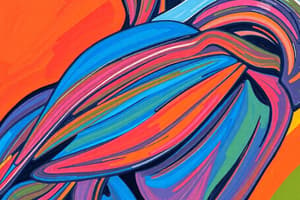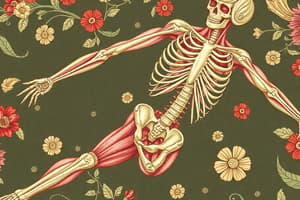Podcast
Questions and Answers
Which type of muscle tissue is characterized by the presence of striations and involuntary control?
Which type of muscle tissue is characterized by the presence of striations and involuntary control?
- Skeletal muscle
- Cardiac muscle (correct)
- Smooth muscle
- Visceral muscle
Myasthenia gravis is an autoimmune disorder that affects the neuromuscular junction, leading to muscle weakness and fatigue.
Myasthenia gravis is an autoimmune disorder that affects the neuromuscular junction, leading to muscle weakness and fatigue.
True (A)
What is the primary function of actin and myosin filaments in muscle contraction?
What is the primary function of actin and myosin filaments in muscle contraction?
Sliding past each other to cause muscle shortening
__________ is a degenerative joint disease characterized by the breakdown of cartilage and underlying bone.
__________ is a degenerative joint disease characterized by the breakdown of cartilage and underlying bone.
Match the following types of joints with their descriptions:
Match the following types of joints with their descriptions:
Flashcards
Locomotion
Locomotion
Movement resulting in a change of location or position.
Skeletal Muscle
Skeletal Muscle
Voluntary muscles attached to bones, responsible for skeletal movements.
Fascia
Fascia
A band or sheet of connective tissue, primarily collagen, beneath the skin that attaches, stabilizes, encloses, and separates muscles and other internal organs.
Myosin
Myosin
Signup and view all the flashcards
Skeleton System
Skeleton System
Signup and view all the flashcards
Study Notes
- Locomotion and movement are key functions in organisms.
Types of Movement
- Different types of movement include:
- Amoeboid
- Ciliary
- Flagellar
- Muscular
Muscle Types
- Skeletal muscle:
- Striated
- Voluntary
- Visceral muscle:
- Smooth
- Non-striated
- Involuntary
- Cardiac muscle:
- Striated
- Involuntary
- Fascia: Connective tissue layer surrounding muscles.
- Myofibrils: Contractile units within muscle cells containing actin and myosin filaments.
- Actin: Thin filaments in myofibrils.
- Myosin: Thick filaments in myofibrils.
Structure of Contractile Proteins
- Actin and myosin are the primary proteins responsible for muscle contraction.
- They are organized into sarcomeres, the functional units of muscle.
Mechanism of Muscle Contraction
- Muscle contraction occurs via the sliding filament theory.
- Myosin filaments bind to actin filaments, pulling them closer together and shortening the sarcomere.
Skeletal System
- Axial skeleton:
- Skull
- Ear ossicles
- Vertebral column
- Sternum
- Ribs
- Appendicular skeleton:
- Limbs
- Pectoral girdle
- Pelvic girdle
Joints
- Fibrous joints: Immovable joints.
- Cartilaginous joints: Slightly movable joints.
- Synovial joints: Freely movable joints with a fluid-filled cavity.
Disorders of Muscular and Skeletal System
- Myasthenia gravis: Autoimmune disorder causing muscle weakness.
- Muscular dystrophy: Genetic disorder causing progressive muscle degeneration.
- Tetany: Muscle spasms due to calcium deficiency.
- Arthritis: Joint inflammation.
- Osteoporosis: Loss of bone density.
- Gout: A type of arthritis caused by uric acid crystal buildup in joints.
Studying That Suits You
Use AI to generate personalized quizzes and flashcards to suit your learning preferences.




